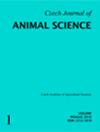根据牛奶中脂肪/蛋白质比例评估奶牛代谢状况对卵巢反应和超排后可移植胚胎数量的影响
IF 1.3
4区 农林科学
Q3 AGRICULTURE, DAIRY & ANIMAL SCIENCE
引用次数: 0
摘要
这项工作旨在根据奶牛的代谢状况、泌乳量和卵巢大小来评估冲洗胚胎的数量和质量。59头泌乳1~5日的荷斯坦奶牛参加了实验。监测是在10月至11月和3月至6月期间进行的。有黄体的奶牛被纳入激素治疗——超排和定时受精。母牛进行了受精,呼吸。再次受精,在诱导热期间,用同一批公牛的受精剂量。第一次受精后第7天进行胚胎冲洗。我们在冲洗后分离出单个胚胎,并在立体显微镜下对其进行形态学评估。受试奶牛的代谢状态是根据胚胎冲洗期间(<1.1;1.1-1.3;>1.3)牛奶中脂肪和蛋白质的比例确定的。有关脂肪和蛋白质含量的数据取自挤奶厅的记录。数据在SAS v9.4中使用GLM程序进行评估。我们的研究结果表明,脂肪/蛋白质比率与冲洗胚胎总数之间分别存在显著关系。可移植胚胎的数量。从脂肪/蛋白质比例在1.1-1.3之间的奶牛组中采集的冲洗和可移植胚胎数量最多。这些值内的脂肪/蛋白质比率表示奶牛处于最佳代谢状态。我们还观察到卵巢的大小与冲洗和可移植胚胎的数量之间存在显著的正相关关系。泌乳次数对监测参数没有显著影响。脂肪/蛋白质比率的评估可能成为评估胚胎移植奶牛的有用工具。我们的发现可用于提高超排系统的效率,目的是提取最大数量的可移植胚胎。本文章由计算机程序翻译,如有差异,请以英文原文为准。
Cow metabolic status assessed from fat/protein ratio in milk affected ovarian response and number of transferable embryos after superovulation
This work aimed to evaluate the quantity and the quality of flushed embryos based on the metabolic status of dairy cows, lactation number, and size of the ovaries. Fifty-nine Holstein cows on 1st to 5th lactation were enrolled in the experiment. Monitoring took place during the period from October to November and from March to June. Cows with corpus luteum were included for the hormonal treatment – superovulation and timed insemination. The cow was inseminated, resp. re-inseminated, during the induced heat with insemination doses from one bull from the same batch. Embryo flushing was performed on the 7th day after the first insemination. We isolated individual embryos after flushing, and morphologically evaluated them under a stereo microscope. The metabolic status of tested cows was determined based on the ratio between fat and protein in milk around the period of embryo flushing (< 1.1; 1.1–1.3; > 1.3). Data about fat and protein content were taken from milking parlour records. Data were evaluated in SAS v9.4 with GLM procedure. The results of our study showed that there is a significant relationship between the fat/protein ratio and the total number of flushed embryos, resp. the number of transferable embryos. The highest number of flushed and transferable embryos were collected from the group of cows with fat/protein ratio between 1.1–1.3. The fat/protein ratio within these values represents cows in an optimal metabolic state. We also observed a significant positive relationship between the size of the ovaries and the number of flushed and transferable embryos. Lactation number did not significantly affect monitored parameters. The assessment of the fat/protein ratio might become a useful tool for the evaluation of cows selected for embryo transfer. Our findings could be used to improve the efficacy of the superovulation system, with the aim to extract the maximum number of transferable embryos.
求助全文
通过发布文献求助,成功后即可免费获取论文全文。
去求助
来源期刊

Czech Journal of Animal Science
Agriculture, Dairy & Animal Science-奶制品与动物科学
CiteScore
2.40
自引率
16.70%
发文量
44
审稿时长
5 months
期刊介绍:
Original scientific papers and critical reviews covering all areas of genetics and breeding, physiology, reproduction, nutrition and feeds, technology, ethology and economics of cattle, pig, sheep, goat, poultry, fish and other farm animal management. Papers are published in English.
 求助内容:
求助内容: 应助结果提醒方式:
应助结果提醒方式:


